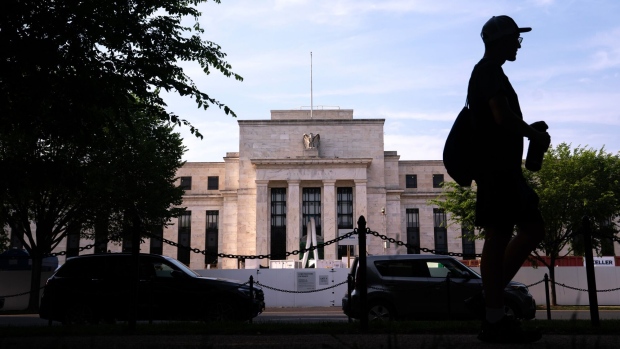Apr 16, 2024
Dollar Heads for Best Run in Year in Bet on Fed Delaying Cuts
, Bloomberg News

(Bloomberg) -- The dollar is headed for its biggest rally in over a year on expectations US interest rates will stay high for longer and as investors pile into the haven currency amid escalating tensions in the Middle East.
The Bloomberg Dollar Spot Index climbed for a fifth day Tuesday, taking gains to roughly 2%, the biggest advance since February 2023. As tensions in the Middle East create risks for commodities prices and the world’s largest economy continues to roar along some investors are starting to worry the strength of the greenback will drag on financial systems outside the US.
“We are potentially breaking out at this point in time,” Quentin Fitzsimmons, a global fixed-income portfolio manager for T. Rowe Price Group Inc. said of the dollar. “If the data continues to hold up, that’s going to feed back into the narrative of — again — higher for longer.”
That could drive tightening of financial conditions across the globe, he said.
The dollar gauge touched a session high Tuesday as swaps traders further reined in expectations for rate cuts after Federal Reserve Chair Jerome Powell called attention to the lack of more progress on inflation.
Traders are now betting the Fed will only begin easing in September or November, compared with July a week ago. The repricing comes after a string of surprisingly strong US inflation readings that are shaking up the prevailing narrative for markets and stoking volatility.
The expected delay of the first US rate reduction is weighing on global currencies as central banks in developed nations begin easing monetary policy. The dollar’s gains have left its Group-of-10 peers in the dust so far this year, with the yen the hardest hit.
“It is one of our top worries that the dollar strength will persist or even get worse,” said Nathan Thooft, global chief investment officer for the multi-asset solutions team and senior portfolio manager for Manulife Investment Management. The Fed will “eventually need to join the party, otherwise the dollar dynamic is going to be much more detrimental to the broader economy — in the US and globally.”
The International Monetary Fund inched up its forecasts for global economic growth this year, citing strength in the US, while warning the outlook remains cautious amid persistent inflation and geopolitical risks. US industrial production rose for a second month, boosted by a larger-than-expected increase in factory output, data showed Tuesday.
China’s move to weaken its daily reference rate for the yuan this week added to the selling pressure across emerging markets.
“It is very hard to fight the dollar bull trend right now,” Chris Turner, head of currency strategy at ING Groep NV, wrote in a note. He expects the dollar benchmark to extend gains and head toward October highs.
Why the Dollar Is Causing Chaos in Emerging Markets: QuickTake
A fresh bout of risk aversion is also filtering through markets, compounding the dollar’s advance. Top Israeli military officials reasserted that their country has no choice but to respond to Iran’s weekend drone and missile attack, raising the prospect of a wider war.
“The increase in geopolitical uncertainty has been the icing on the cake,” said Roberto Cobo Garcia, head of G-10 FX strategy at Banco Bilbao Vizcaya Argentaria SA in Madrid, referring to the dollar’s allure as a haven.
Custodial data held by State Street shows that institutional flows into the greenback in the five days to April 11 hit their highest since November 2022. Asset managers have been selling the euro in particular, adding to their already underweight positions on growing conviction of upcoming rate cuts by the ECB. The Canadian dollar has also seen an exodus.
“Data surprises have reinforced that idea that interest rates will diverge after all, with rates falling across European economies in the summer but perhaps not in the US,” said Michael Metcalfe, head of macro strategy at State Street Global Markets.
(Adds comments from Fed Chair starting in fifth paragraph, updates markets data throughout.)
©2024 Bloomberg L.P.






